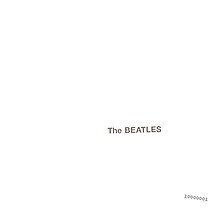White Album
| The Beatles | |||||
|---|---|---|---|---|---|

The original vinyl copies released in 1968 had the band's name blind embossed on a white background. These pressings were also numbered. Design by Richard Hamilton.
|
|||||
| Studio album by The Beatles | |||||
| Released | 22 November 1968 | ||||
| Recorded | 30 May – 14 October 1968 | ||||
| Studio | EMI and Trident Studios, London | ||||
| Genre | |||||
| Length | 93:35 | ||||
| Label | Apple | ||||
| Producer | George Martin | ||||
| The Beatles chronology | |||||
|
|||||
| The Beatles North American chronology | |||||
|
|||||
| Professional ratings | |
|---|---|
| Review scores | |
| Source | Rating |
| AllMusic | |
| The A.V. Club | A+ |
| The Daily Telegraph | |
| Encyclopedia of Popular Music | |
| MusicHound | 4/5 |
| Pitchfork Media | 10/10 |
| PopMatters | |
| Q | |
| The Rolling Stone Album Guide | |
| Slant Magazine | |
The Beatles, also known as the White Album, is the ninth studio album by English rock group the Beatles, released on 22 November 1968. A double album, its plain white sleeve has no graphics or text other than the band's name embossed, which was intended as a direct contrast to the vivid cover artwork of the band's earlier Sgt. Pepper's Lonely Hearts Club Band. Although no singles were issued from The Beatles in Britain and the United States, the songs "Hey Jude" and "Revolution" originated from the same recording sessions and were issued on a single in August 1968. The album's songs range in style from British blues and ska to tracks influenced by Chuck Berry and by .
Most of the songs on the album were written during March and April 1968 at a Transcendental Meditation course in Rishikesh, India. The group returned to EMI Studios in May to commence recording sessions that lasted through to October. During these sessions, arguments broke out among the Beatles, and witnesses in the studio saw band members quarrel over creative differences. Another divisive element was caused by the constant presence of John Lennon's new partner, Yoko Ono, whose attendance at the sessions broke with the Beatles' policy regarding wives and girlfriends. After a series of problems, including producer George Martin taking a sudden leave of absence and engineer Geoff Emerick quitting, Ringo Starr left the band briefly in August. The same tensions continued throughout the following year, leading to the eventual break-up of the Beatles in April 1970.
...
Wikipedia
